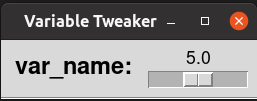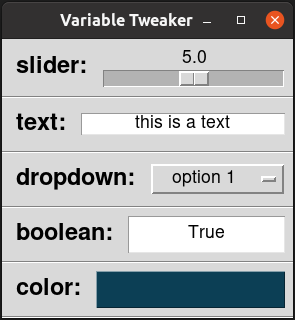Change variables dynamically in runtime with the help of a simple GUI
Project description
Change variables during runtime using simple GUI. ## Installation
pip install dynamic_variables
Usage
Here is a minimalist example
from dynamic_variables import VariableTweaker
import time
vt = VariableTweaker()
vt.add_slider('var_name', 0, 0, 10, 0.1)
vt.init_gui()
while True:
print(vt.var_name)
time.sleep(0.1)When this program run, a slider appears and vt.var_name changes according to this slider.

Slider Window
Breakdown
vt = VariableTweaker() creates an object of VariableTweaker class. This object is used to create dynamic variables and gui.
vt.add_slider creates a slider inside the gui and a float variable named var_name. This variable is connected with the slider and changes with the slider, and can be used throughout the code. Slider is one of 5 widgets. All widgets and their usage covered in widgets section.
vt.init_gui() Initializes the GUI.
Widgets
There are 5 widgets that you can add to GUI. They allow manipulating different types of variables.

Slider Window
Slider
Slider widget allows you to change int or float variables easily.
add_slider(variable_name, initial_value, min_value, max_value, step_value)Example:
vt.add_slider('slider', 5, 0, 10, 0.1)Text
Text widget allows you to change str variables.
add_text(variable_name, initial_value)Example:
vt.add_text('text', 'this is a text')Dropdown
Dropdown widget allows you to change your variable to any predetermined value.
add_dropdown(variable_name, initial_value, list_or_tuple_of_options)Example:
vt.add_text('dropdown', 'option 1', ['option 1', 'option 2', 3, 4.5])Boolean
Boolean widget allows you to change your bool variable
add_boolean(variable_name, initial_value)Example:
vt.add_boolean('boolean', True)Color
Color widget allows you to pick colors easily. When clicked on the color, a color picker shows up for you to choose a color.
add_color(variable_name, initial_value)initial_value must be a tuple (r, g, b) or a colorcode #xxxxxx. Example:
vt.add_color('color1', (12, 63, 85))
vt.add_color('color2', '#0c3f55')When accessing the color variable, r, g, b and color_code parts are available.
print(vt.color.r, vt.color.color_code)Example Application
import cv2 as cv
from dynamic_variables import VariableTweaker
# Set up dynamic variables
vt = VariableTweaker()
vt.add_text('text', 'Threshold')
vt.add_slider('x', 0, 0, 100, 1)
vt.add_slider('y', 0, 0, 100, 1)
vt.add_slider('scale', 1, 1, 5, 0.01)
vt.add_slider('thickness', 1, 1, 10, 1)
vt.add_color('color', (0, 0, 0))
vt.add_dropdown('threshold_type', 'None', ['None', 'Normal', 'Adaptive Gaussian', 'Adaptive Mean'])
vt.add_slider('thresh', 100, 0, 255, 1)
vt.add_slider('block_size', 3, 3, 201, 2)
vt.add_slider('C', 0, -100, 100, 1)
vt.init_gui()
# import image
image = cv.imread('image.png')
while cv.waitKey(20) != ord('q'):
# Apply Threshold
copy = cv.cvtColor(image, cv.COLOR_BGR2GRAY)
if vt.threshold_type == 'Normal':
_, copy = cv.threshold(copy, vt.thresh, 255, cv.THRESH_BINARY)
elif vt.threshold_type == 'Adaptive Gaussian':
copy = cv.adaptiveThreshold(copy, 255, cv.ADAPTIVE_THRESH_GAUSSIAN_C, cv.THRESH_BINARY, vt.block_size, vt.C)
elif vt.threshold_type == 'Adaptive Mean':
copy = cv.adaptiveThreshold(copy, 255, cv.ADAPTIVE_THRESH_MEAN_C, cv.THRESH_BINARY, vt.block_size, vt.C)
copy = cv.cvtColor(copy, cv.COLOR_GRAY2BGR)
# Put text
copy = cv.putText(copy, vt.text, (vt.x, vt.y), cv.FONT_HERSHEY_SIMPLEX, vt.scale,
(vt.color.b, vt.color.g, vt.color.r), vt.thickness)
# Show image
cv.imshow('Image', copy)
Slider Window
Project details
Download files
Download the file for your platform. If you're not sure which to choose, learn more about installing packages.











